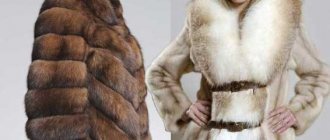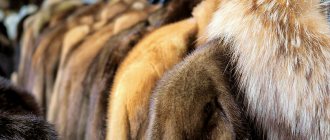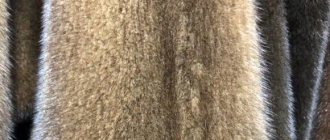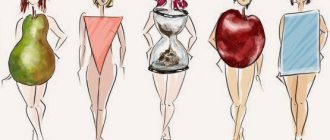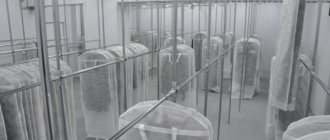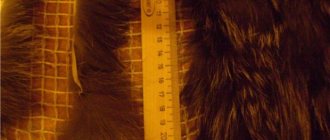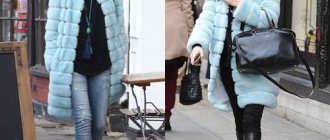The trim on the hood made of natural and even faux fur will further decorate any jacket. In addition, such an edge not only insulates the hood itself, but also protects the face well from the piercing wind.
In this article, you will clearly see in the photo how you can make a hood trim with your own hands, you will learn how much fur you need and many of the nuances of the technology for making a detachable trim.
How to work with flesh and what it is
A little theory. The fur is attached to the skin (in professional language this is called mezdra). When sewing together several plates of the mesh, many sew with a regular seam over the edge; subsequently, such a seam breaks, simply because when tensioned, the thread cuts through the mesh and the seam unravels. Also incorrect in use is an overcast seam, which tightly connects the core plates, but does not itself stretch along with the product, it tightens the seam, the seam becomes noticeable from the face of the product, often the product still needs to be pulled on a block or on a pattern. So there is a very simple seam that solves all the important problems when working with the delicate flesh of fur products.
Step-by-step instructions for sewing fur trim to the product
- The first stitch is a regular overstitch.
- And the next stitch (also over the edge), BUT not into a new hole, but into the same hole that was made during the first stitch.
- We make the third stitch in a new hole, the fourth in the same one. It looks like a zig-zag over the edge.
And thus, every second stitch is made into the previous hole:
The seam remains elastic. At the same time, it tightly connects the membrane and does not separate. The threads do not cut into the interior and allow the product to be pulled. Even if the thread breaks during operation, THE SEAM WILL NOT FALL AWAY! The thread does not creep; it is pressed tightly by the adjacent stitch.
Important tips when working with real fur!
Also, a little advice to everyone who has never sewn fur onto a fabric product before.
First, sew bias tape to the fur along the entire contour (with a furrier's stitch, of course), then tuck the tape inward (under the fur). But you need to sew the binding to the product, grabbing it close, close to the seam with the flesh. Thus, there will not be a large load on the mesh during use and it will tear when the fabric stretches during use.
In the photo I am sewing a strip of fur trim, which will later live on the hood.
Good luck everyone! I hope I helped with advice for everyone who decided to sew natural fur for the first time. Now you can sew a trim to your favorite jacket, hat, dress and other things!
In conclusion, I would like to invite you to watch a video on how to sew a stole of fur onto a silk scarf:
[Total: 11 Average: 2.7/5]
How to sew and make a fur trim from pieces and tails?
Yes, you can make a fur trim from ponytails or leftover fur. You will spend a little more time, but the result will exceed all your expectations and efforts!
- We open our ponytails, as in the example, or smooth out the existing pieces. As a result, we should get even stripes. For smoothing we use an elastin solution. It is more convenient to use a spray bottle for uniform spraying.
Important: Do not use ordinary water! Once dry, the skin becomes very rough.
We comb every piece well!
- Now we cut off pieces of leather or natural suede to the required length, but no more than 1 cm in width! If you make a larger distance between the pieces of fur, then the edge will end up like an accordion with creases at the transition points.
- The example shows working with ponytails, but the situation is similar with any pieces! You sew on a strip of fur, a strip of leather. And so you alternate until the desired length (about 70 cm).
Important: When sewing pieces together, pay attention that the fur must be in the same direction!
Make sure you get an even rectangle!
Tip: If you don’t have enough fur, you can cheat a little - cut the pieces or tails in half. And sew them together, alternating with pieces of fabric.
If there is not enough material
- Then you cut a rectangle of the required width or simply cut off the irregularities. And now you insert a zipper, make eyelets, or simply sew it onto the hood!
- If you have thick and fluffy fur, then you don’t need to use the lining. Fold the fur in half, sew a piece of fabric on both sides to the fur rectangle. This segment can be from 0.5 to 1.5 cm in width. The longer the fur, the larger the section so that the zipper does not “chew” the pile every time it is opened.
We only sew the zipper onto fabric!
- And already sew a zipper onto these pieces of fabric. As if you insert it between these pieces of fabric. Ideally, they should match the color of the top product.
How to sew fur pelts by hand stitching
Fur parts, unlike leather, are joined either by hand or on a special furrier's machine. Sewing fur on a conventional sewing machine makes the seam stretched and of poor quality, and besides, the leather fabric of the fur may tear from this method of joining. There are several techniques for joining fur skins by hand; I suggest you study one of the options for a manual furrier’s seam with a “double puncture”.
First, the edges of the two skins to be sewn are folded with the hair inward so that the hair is not visible during sewing. The needle should pierce both skins towards itself, that is, from the reverse side, but you can start from the left edge or the right, whichever is more convenient for you. The main thing is to figure out how to make such a stitch.
Flower nursery Green Gate
Do you like indoor or garden flowers? At the Green Gate nursery you can buy rooted cuttings and divisions of various domestic and perennial garden flowers. We have a constantly updated collection of anthuriums and hibiscus. Flowers and plants are sent by mail.
The furrier's hand stitch is made with simple stitches across the edge from right to left with a small step between stitches. Stitch forward, stitch in place, into the same holes from the needle, and again stitch forward, stitch in place, etc. Experienced furriers always repeat the stitch, that is, the needle always goes through the same hole twice. Stitch density (0.3-0.5cm) and stitch height (0.3-0.8cm) depend on the thickness of the leather fabric. The thicker the fur pelt, the higher the stitch, and vice versa.
After joining the fur skins with a furrier's seam, both parts are unfolded, the seam is straightened by tapping along it with a small hammer from the side of the leather fabric. The seam is smooth, flat and strong, and the edges of the connected parts are positioned end-to-end.
A slight difference in the hair length of the two skins being sewn together can be evened out by moving the edge of the skin with the longer hair upward. In this case, the stitch should be tightly tightened. By the way, when performing a hand furrier's stitch, you should not tighten the thread too much; it is enough to simply “pick up” the slack in the thread. It is much more important to maintain the same thread tension in each stitch.
Video on how to repair a bald spot on a fur coat, this method is called the “fish cut.” A very simple way to save on fur coat repairs. All you need is a needle and thread.
How to sew a removable trim made of natural fur onto the hood of a jacket. Part 1
In this master class I want to share an easy way to sew a removable trim onto the hood of a jacket with insulation.
For work you will need: a hood, a zipper for fur, a strip covering the zipper made of the main fabric, braid for sewing to the fur and fur (in my case, natural).
1. We adjust the upper hood to the insulation and connect it to the central part. Let's put it off. We punch through the eyelets and insert the lace with clamps.
3. Draw a line for the position of the zipper for the detachable edge. Top - 4 cm from the edge, bottom - 10 cm.
4. Parts to work:
- a strip covering the zipper 8 cm wide and long (height * 2 of your hood); — detachable zipper 75 cm long (in my case); - two braids for sewing fur to the zipper (length longer than the zipper, 6 cm.
5. Fur for the edge.
6. Sew on the zipper. The distance from the bottom is 3 cm. Take the part of the zipper without the slider and sew it face up 2 mm right through the zipper.
7. Finished view on the right side of the hood.
8. Finished view on the left of the hood.
9. Fold and stitch in half (lengthwise) the strip that covers the zipper on the hood.
10. Sew the strap on the hood butt to the zipper 3 mm from the cut.
11. View of the hood with a zipper and a placket.
12. Turn the plank in the direction of the cut and secure the ends of the plank.
What can you sew from faux fur with your own hands?
Warm, beautiful outerwear from fur coats to vests, durable and wear-resistant hats, visually very attractive decorative items and individual elements of any textile products (for example, fur sewn to the hood or on the collar of a coat, or pieces of fur in the trim of skirt pockets) - here only a small list of models that require synthetic fur on a knitted basis. Do you want a jacket? Please! Would you mind giving up a sheepskin coat, a fur coat and a coat? There are a lot of options for sewing warm and spectacular models.
The edging on the hood can be sewn in different ways
The edging on the hood can be made in different ways. We present the simplest of them, with a lining. After you “fasten” the edge, you need to unscrew it and perhaps even lightly manually secure it to the hood with threads.
In addition to this method, the edge can be made without lining. You can make the edge permanent. But these methods will require certain skills and abilities.
In this video you will see how a furrier machine works. We sew together two small pieces of fur especially for you.
Scarf with fur on head: outfit for cold winter
Fur is a versatile material that never goes out of style. Fur always looks rich, luxurious and at the same time elegant. The combination of a scarf and fur in general has recently been on the wave of fashion trends. Moreover, such a scarf does not have to be worn on the head; original capes, vests and ponchos are made from them. Let's talk about how to sew a fur-trimmed scarf yourself.
First stage: preparation
Creating such a headdress opens up a wide field for imagination: color, shape, selection of combinations.
First, you need to decide on the shape of the future hood. Here the choice is limited: either square or triangular.
Shawl with fur trim
Then you should decide which part of the scarf will be trimmed with fur . It can be completely sheathed along the edge, but in this case it is worth keeping in mind that such a product will be more convenient to wear on the shoulders. The rich fur trim of the bonnet makes it very heavy and bulky, so tying such a scarf on your head will be difficult.
Shawl with fur trim
The most popular option is a partial trim, so that the fur in a tied scarf only frames the oval of the face . You can take the creative ideas of some designers as a basis and trim not only the area around the face, but also make beautiful stripes or patterns throughout the entire canvas. The choice of fabric is also quite simple. It is enough to decide what time of year the product will be worn. If it is severely cold, then, naturally, it is better to choose a woolen scarf: it will both warm you and protect you from the wind.
Light, natural fabrics are perfect for the spring-autumn period. Fur, by the way, can be used from the hood of a jacket or down jacket that has not been worn for a long time. Typically, mink, sable, arctic fox or fox are chosen for edging scarves.
It should be noted that it is necessary to take into account the color combination of the scarf with fur. The finished product should look harmonious, and the fur on it should be expensive and elegant.
Pay attention to the width of the fur strip: it should not look like a pile of fur covering both the fabric of the scarf and the face.
Second stage: cutting and sewing
Usually they take a ready-made scarf, bought ahead of time in a store. You can, of course, sew it yourself from start to finish. Fortunately, this does not require any special skills or deep knowledge of sewing. The pattern for the future scarf can be found here.
Pattern of a scarf with fur
Tools
To work with a scarf with a fur trim you will need:
- Tailor's scissors.
- Tape measure.
- Sewing machine.
- Overlock.
- Furrier's needle.
- A sharp knife for cutting fur.
- Chalk or bar of soap.
- Iron.
The first step is always measurements. Using a regular measuring tape, measure the required length and width on an ironed piece of fabric. All measurements are marked on the fabric with a piece of soap or a special chalk. If the choice was made on wool, then it is better to wash it first so that the piece becomes softer. Don’t forget to make 1 cm indentations on each side, which will later go into folds. After this you can start cutting.
The length of the fur strip should also be measured and marked on the scarf where the trim will begin and end. Then a piece of the required width and length is cut out of the skin. If it is not possible to cut out a whole strip, it can be sewn from several pieces.
Note : fur is a delicate material and can be worked either manually or using a special sewing machine. It is better to cut out a fur strip with a special sharpened knife. Using scissors, you can accidentally cut off hairs and thereby damage the future edging.
First, on a cut piece of fabric for the future scarf, the edges are processed using an overlocker. Then the folds are thoroughly ironed and stitched using a sewing machine. Sewing the fur and scarf is the most important stage in the entire work. It is best to join fabric and fur by hand. It is worth keeping in mind that the seam should be zigzag. A straight seam will cause too much tension and additional stress on the “underside” of the fur, better known as the mesh. Ultimately, such a scarf will not last long: in places of strong tension along the seam, the edge will simply tear.
The presence of a lining between the fur and the fabric is mandatory. It can be fleece, special lining fabric or another thin scarf. It is best to use a long and thin needle.
Afterword
The most common type of scarf with fur is the Pavloposad one. It is used not only as a headdress, but also as a basis for creating other accessories: stoles, mittens, vests, capes. A characteristic feature of Pavloposad shawls is considered to be rich ornamentation combined with luxurious fur . All this splendor looks rich and beautiful.
However, the Pavloposad factory was never limited to creating the same type of products. The shawl manufactory has a rich history: from the creation of shawls with ancient pagan symbols as the basis of the ornament to revolutionary products with flashy patterns during the formation of Soviet power. The factory even has its own museum of scarves, through the exhibits of which you can, like Ariadne’s thread, follow the path of fashion development.
Even in bitter frosts and heavy snowfalls, a woman tries to look beautiful and elegant. Since time immemorial, Russian women have always had scarves in their wardrobe. Fashion constantly amazes with its new products, and at the end of the last century, fashionistas began to flaunt shawls trimmed with fur. Initially, these were scarves of bright colors with geometric patterns. Today, scarves are preferred in classic floral colors.
Hood: how to make a pattern with your own hands
In this master class we will tell you in detail how to make a hood pattern yourself and connect it to the product.
Step 1. Take measurements
The hood must be sewn exactly to the head, so that it does not hang over the forehead or fall back. In addition to this, its bottom edge must exactly match the width and depth of the neckline. For this reason, it is important to take measurements as accurately as possible.
You will need:
Hood height
Divide the resulting number by 2 - this is the height of the front (front) edge of the hood. Using this measurement, you will draw the front line of the hood (face) on a paper pattern.
Hood width
Attention!
Neckline
You will need to “adjust” the pattern to the neckline of the product to which the hood will be sewn. It is best to do this using a finished (almost sewn) product with the edges of the neckline processed by facing. To draw a drawing of a hood pattern, you need to take the following measurements (see picture below):
A = half the width of the front neckline or the width of the front neckline (measured from the middle line of both the front and the front, that is, excluding facings, fasteners, etc., to the shoulder seam). Measure the width of the neckline using a flexible measuring tape, or better yet, a string.
B = half the width of the back neckline (measured from the center back line to the shoulder seam).
C = front cutout depth. On the pattern, draw an auxiliary line through the shoulder seam point perpendicular to the front neckline line (face). Try on the product and measure (preferably using a cord) the distance from the point of the shoulder seam to the lowest point of the neckline along a line running at a right angle.
D = back cutout depth. See “front neckline depth.”
Now transfer the measurements to the hood pattern and draw a smoothly curved line as shown in the picture.
Step 2. Draw a pattern
We obtained the height and width of the hood, and also drew a smooth line for sewing the hood into the neckline and marked the point of alignment with the shoulder seam. Now we need to decide on the shape of the hood.
How to sew fur to gloves: basic requirements
For finishing, you can use any fur, but more beautiful things are obtained from the thick and long hair of arctic fox, fox and raccoon. A rabbit is a good budget option, but you can also use faux fur. Of course, mink will also look good, especially in the form of cuffs. But it is important not only to sew fur onto the product correctly, but also to arm yourself with several important rules.
You can sew fur onto gloves yourself
- When cutting fur trim, keep in mind that you cannot cut fur with scissors! To do this, use a furrier's knife, a stationery knife or a blade in a special holder. In this case, you do not need to put too much pressure on the fur - you can touch and trim the fur on the other side. We work with light movements. Only rabbit fur or artificial material can be cut with scissors. But you still need to work carefully!
- The connection of fur trim to the product can be done in different ways - both directly and using a lining. In principle, the fur on gloves is not subject to such great deformation as, for example, pockets. But when creating a cuff, it is still better to duplicate the parts - this will increase the wear resistance and strength of the material. The following dubbing materials for fur are distinguished: non-woven fabric, as the most economical option with adhesive application. It is important to take low-temperature material so as not to burn the flesh;
- dublerin with drops of glue on one side is also worth taking only low-temperature. This type is suitable for leather and fur. And just a little advice - this material is much stronger and not as elastic as non-woven fabric. Therefore, craftsmen often choose it, especially when sewing expensive and large products;
- there is also a sideboard. Satin, chintz, bias tape or simple braid are similar. These materials do not stretch and keep the fur from stretching. Sew strictly along the edges of the product.
How to duplicate fur
- You can add fur to the gloves themselves: sew them with a hand stitch
- sew on a machine with preliminary spacer of the parts in the right place
- glue
Important: If you put fur on a web, then keep in mind that you still need to duplicate it onto the tape and manually sew the product to this tape from the wrong side.
- It is worth highlighting this glue for sizing fur: PVA for leather
- Nairit
- Dismocol glue
- ordinary moment
Single sided tape
- The threads used for sewing mezdra must be very strong. But keep in mind that they should not cut the flesh! Don't use cotton threads! The best option is polyester.
- It is better to take a furrier's needle No. 40.
- For sewing fur parts, goat, zigzag or furrier stitches are used. The last type is the most durable and is suitable if you do not have a furrier at home. After all, on a regular machine, some seams can go in waves. In addition, it is more convenient to sew onto gloves using a hand seam. Its big advantage is that each stitch is closed and when the thread breaks, the seam does not come apart. It is performed obliquely, and then duplicated into the same hole with the needle directed towards you.
The seam
How to make a edging on a hood
To sew a detachable edge, you will need a twisted detachable zipper 60 cm long and a lining. The wrong side of the lining is applied to the front part of the fur and sewn on manually (furrier's stitch) or on a furrier's machine. You can sew it on a regular machine, but then you will first need to baste the lining. A zipper is installed on one side of the edge between the lining and the fur.
Leave a small section through which to turn the edge out. Then sew it up by hand.
Some seams need to be taped
Some areas of fur clothing need to be duplicated, for example, hem, collar, hem and others. Duplicating with cushioning material will protect them from stretching and give them the required shape. It is imperative to strengthen connecting seams such as armhole seams, neck seams, and shoulder seams. These areas are subject to stretching and the tape sewn into the seam strengthens and strengthens it. In sewing accessories stores you can buy regular cotton tape 1.5-2cm wide and use it for these purposes. There are also special adhesive tapes, which furriers call “amplifiers”. They are also used when sewing products made from genuine leather. The tape is placed on one side.
Technology for cutting faux fur at home
Let's decide on the set of necessary tools: to cut the fur, you must have fairly sharp cutting scissors or a stationery knife. Cutting should be done from the inside out, exclusively in the direction of the pile. There is no need to cut the lint - we only cut the knitted base without touching the lint, removing the lint with the objects used for cutting. Long pile can be pulled apart with a regular comb. If you are cutting with a knife, do not use a cutting mat to avoid accidentally cutting the pile. Avoid applying excessive pressure to the base when cutting.
The pattern is transferred to the fur base with special felt-tip pens, chalk or pins on the reverse side. To cleave parts, it is better to use long and strong pins with bright rounded heads - with such support it is easier to sew parts together.
How to connect fur parts? It's easy to do!
1) The stitch on a sewing machine (regular, not furrier’s) is laid in the direction of the pile (from top to bottom). Perpendicular to the stitching, the parts can be joined with long pins, manually, to avoid displacement.
2) If you plan to sew pieces with long pile, use scissors to tuck it inside. Then sew the parts to each other, and at the end, remove the lint from the front side with a darning needle and fluff the lint.
3) How are allowances processed? The pile on the allowances of the parts must be cut off; to do this, straighten the allowances in different directions. The edges of the lint-free allowances must be sewn to the product from the inside out using an over-the-edge seam. Processing the bottom of faux fur products can be done manually using cross stitches. There is no need to iron the folded bottom edge. It is better to process the edges of products made of thick, long-pile fur by machine - trim them with a facing made of lining material.
Where to start modifying a fur coat
At the beginning of work on shortening a fur coat, you need to prepare the necessary items so that during the repair process you will not be distracted while looking for the necessary item. All you need is:
- strong contrasting and fur-colored threads;
- centimeter;
- needles;
- flat chalk or soap;
- sharp scissors, blade.
Visually, it is very difficult to determine the length of a fur coat so that it turns out to be optimal. Therefore, you need to straighten it, comb it and definitely put it on. The mirror should provide a full-length image. During the fitting process, it is extremely important to use shoes with which the reconstructed mink coat will be worn in the future. If new boots are just in your plans, shoes whose heels match the desired height of your future purchase will also work.
How to choose the right fur skins
Working with fur has one important advantage - you can always add a missing piece to any part or replace a section of fur skin with another, since the connecting seam will be hidden in thick hair.
The fur pelts of any fur-bearing animal are never exactly the same. They differ in size, hair height, shade, and sometimes some skins have “bald spots” and other defects. In general, selecting fur is the most important skill for which a good furrier is valued.
The correct selection of fur will make the fur coat “monolithic”, as if sewn from one large skin, without focusing on the joining of skins of different quality and shade. A good master furrier, like a sculptor, feels the fur and sculpts a real work of art from different pieces, which is why sewing fur products is the most expensive service of the atelier. It is difficult to give any specific recommendations on the selection of skins, but when sewing, for example, a fur vest, place the best pieces of skin (back) on the center of the front and back. It is advisable to install the side parts of the skins in other places, for example, in the side seams. When connecting different pieces of fur skins, pay attention to the height of the fur and its shade. Attach them to each other and compare, if they fit, connect them together.
Making changes to the style of a fur coat
You can improve the style a little, which will change the mink coat and become fashionable again, with your own hands. There is no need to go to a studio and pay a fairly large amount for simple work.
There are several methods to give a modern look to a fur coat, which can be done at home:
- trim the hem;
- shorten the sleeves;
- change collar;
- make trims from other fur at the cuffs, collar and hem.
Otter fur is considered the most wear-resistant.
Fur skins have a standard of wearability. Otter fur is considered the most durable and resistant to waterlogging. It is the otter that has the honor of being the standard for all fur-bearing animals, and the fur of fur-bearing animals is compared against it. Even sable fur is inferior to it in strength and wear resistance.
So, if otter fur is 100%, then sable has 80%, mink - 70, arctic fox - 65, astrakhan fur - 60, fox - 50, muskrat - 45, squirrel - 30, ermine and weasel - 25, rabbit - 12, mole and gopher – 10, hare – 5.

